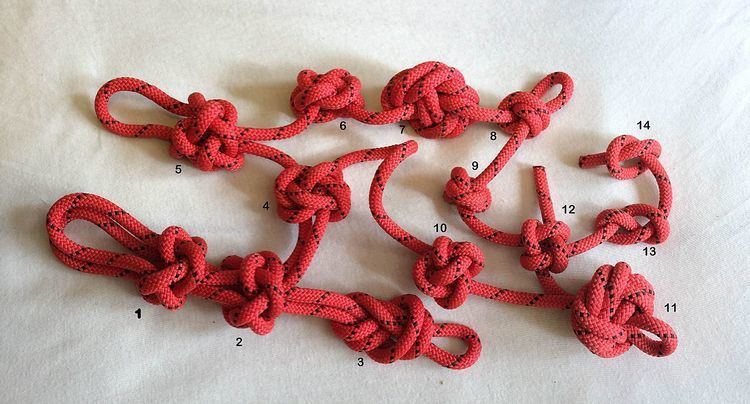 | ||
Names Stopper knot, Backup knot, As numbered in picture : 1- Fiador, 2- Sailor's diamond (#693), 3- Figure-eight loop, 4- Diamond, 5- knife lanyard, 6- Chinese button, 7- Chinese button doubled, 8- True lover's, 9- Ashley's, 10- Celtic button, 11- Celtic button on the bight (and thus doubled and with lanyard loop), 12- Friendship, 13- Figure-eight, 14- Overhand Typical use Keeps the line from slipping out of things. | ||
A stopper knot (or simply stopper) is a knot that creates a fixed thicker point on an otherwise uniform thickness rope for the purpose of stopping the rope at that point from slipping out of a narrow passage. Stopper has three distinct meanings in the context of knotting and cordage.
Contents
At the end of a line
A stopper knot is tied at the end of a rope to prevent the end from unraveling. It then functions like a whipping knot.
A stopper knot is tied at the end of a rope to prevent the end from slipping through another knot, or passing back through a hole, block, or belay/rappel device. It then functions like a leash handle. Knots commonly used for this purpose are:
The Chinese button knot and the Celtic button knot are decorative stopper knots.
Around the standing part
When a stopper knot is tied outside another knot and around the standing part it can also be called a backup knot. Tying the end around the standing part helps prevent the knot from unraveling by not allowing the end to slide back into the knot: a kind of insurance against failure of the knot. Examples of this usage are often seen in climbing, rope rescue, and other safety-of-life situations. Common knots used for this purpose are:
Nautical usage
In nautical settings, a stopper may refer to a length of rope that is belayed at one end with the other end attached to a tensioned main line using a friction hitch in order to tension the stopper and thereby slacken the portion of the tensioned main line behind the friction hitch. For example if a sheet becomes jammed on a winch while under sail, a "stopper" can be used to temporarily take the strain off the winch while the riding turn is cleared.
